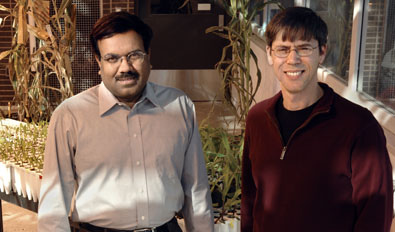Inside Iowa State
Inside ArchivesSubmit newsSend news for Inside to inside@iastate.edu, or call (515) 294-7065. See publication dates, deadlines. About InsideInside Iowa State, a newspaper for faculty and staff, is published by the Office of University Relations. |
Feb. 29, 2008 
Patrick Schnable (right) and Srinivas Aluru provided expertise in corn genomics and supercomputing to a national corn genome project. Photo by Bob Elbert. Iowa State team helps piece together corn genome's first draftby Mike Krapfl, News Service Iowa State researchers helped write the first draft of the corn genome sequence that was announced Feb. 28 at the 50th annual Maize Genetics Conference in Washington, D.C. Patrick Schnable, Baker Professor of Agronomy and director of the Center for Plant Genomics and the Center for Carbon Capturing Crops; and Srinivas Aluru, Stanley Chair in Interdisciplinary Engineering and professor of electrical and computer engineering, led the work at Iowa State and provided the project with expertise in corn genomics and supercomputing. "We are proud that Iowa State University researchers have contributed to this draft sequence of the corn genome," president Gregory Geoffroy said. "Understanding the corn genome will accelerate efforts to develop crops that can meet society's growing needs for food, feed, fiber and fuel. This project also is a wonderful example of how Iowa State researchers are able to work across disciplines to solve problems important to Iowa and the world." The teamThe genome project is led by Richard Wilson, director of the Genome Sequencing Center at the Washington University in St. Louis School of Medicine. The project also includes researchers at the University of Arizona, Tucson, and the Cold Spring Harbor Laboratory, New York. The $32 million, three-year research project is supported by the National Science Foundation and the U.S. departments of Agriculture and Energy. The Iowa State scienceSchnable and Aluru led Iowa State's work to refine assemblies of the genomic sequences generated by researchers at Washington University. In addition, they identified almost 100 genes with nearly identical copies in the genome. Schnable said these nearly identical paralogs may have played important roles during the evolution and domestication of corn and may have contributed to the ability of breeders to mold this important crop species to meet human needs. The Schnable and Aluru teams also discovered several hundred new corn genes that are not present in other plants. Some of these genes may be responsible for unique attributes of corn. The corn genome is an especially difficult jigsaw puzzle to put together, Schnable said. There are some 2.5 billion base pairs that make up the double helix of corn DNA. The corn genome also has long lines of repetitive code. And corn has 50,000 to 60,000 genes to identify and characterize. That's about twice the number of genes in humans. Plus, 50 percent or more of the corn genome is made up of transposons or jumping genes. Those are pieces of DNA that can move around the genome and change the function of genes. Solving all those assembly challenges took a lot of computing power and some new software technology. Aluru and his research team developed software called "PaCE" and "LTR_par" that runs on parallel computers. PaCE can generate draft genome assemblies in hours or days instead of months. LTR_par identifies retrotransposons, another mobile genetic element that can cause genome changes such as mutations, gene duplications and chromosome rearrangements. The implicationsSchnable said the resulting draft of the corn genome provides plant scientists with a lot of data to work with. "This will enable so much exciting corn research," he said. "This will raise questions about the biology of corn and provide great tools to answer them." For example, the genome could help scientists:
The genome of corn is very similar to the genomes of rice, wheat, sorghum, prairie grasses and turf grasses. Therefore, Schnable said, the draft of the corn genome can help researchers improve the other cereals and grasses. |
Quote"This will raise questions about the biology of corn and provide great tools to answer them." Patrick Schnable |